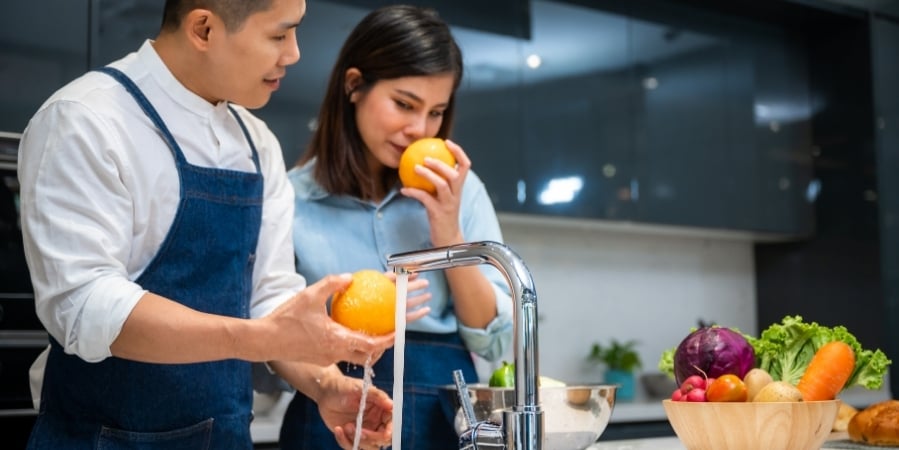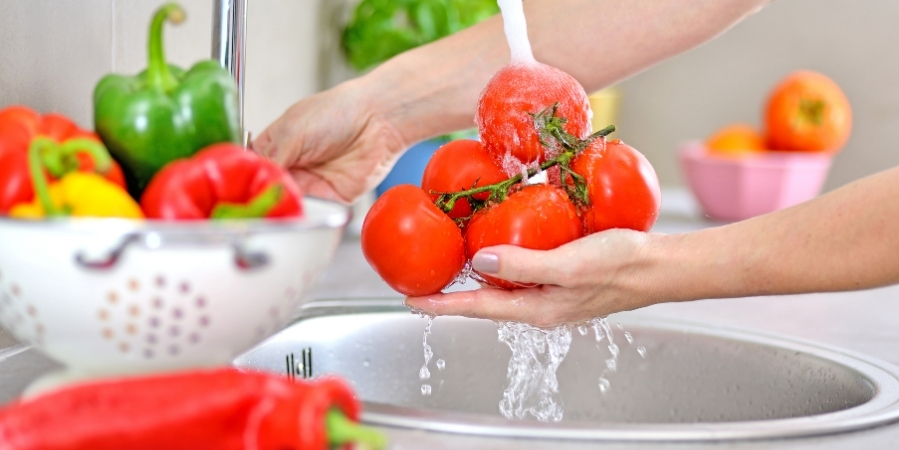Eating a diet that includes lots of fruits and vegetables provides important health benefits and nutrients. Considering the nutritional benefits fruits and vegetables provide, it is important to select, clean, and prepare them safely.
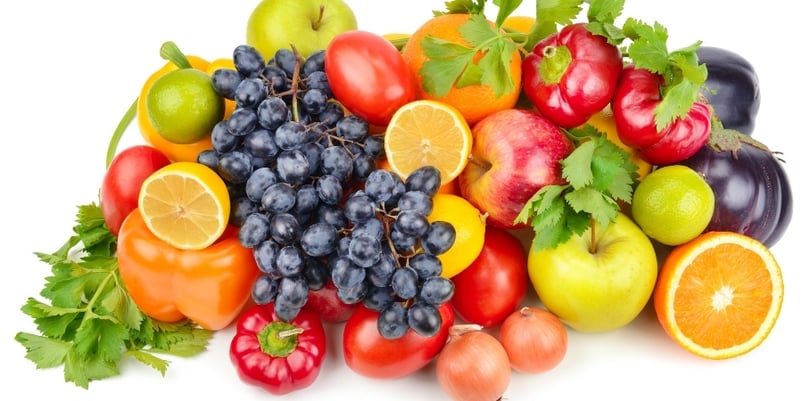
The Best Way to Wash Fruits and Vegetables
While purchasing ready-made sprays and cleaners from your local grocery stores may seem ideal, research has found that a simple solution of either vinegar or baking soda will do the trick to having clean produce.
Food preparation and sanitization can be made easy by using these two basic everyday household items commonly used to clean produce.
So which one should you use? Here are a few major reasons why these are the easiest and effective ways to wash your produce.
Should I Wash My Fresh Produce in Vinegar?
Whether it's to clean or sanitize a variety of fresh fruits and vegetables, vinegar is a safe choice to use as a great at-home cleaning remedy.
Lingering on the surface of fruits and vegetables are many different fungi and bacteria, which can be effectively removed by using vinegar.
Depending on the type of bacteria, the type of fruit or vegetable, the concentration of the vinegar, and how long you intend to soak your produce, vinegar's effectiveness can vastly differ.
Although vinegar is a great way to clean your produce, it can be quite expensive over time and sometimes leaves foods with an unpleasant vinegary taste. If you run into problems like this, don't panic; there is another alternative solution, baking soda!
Although vinegar is a great way to clean your produce, it may not be the most cost efficient option over time and sometimes leaves foods with an unpleasant vinegary scent. If you run into problems like this, don't panic; there is another alternative solution, baking soda!
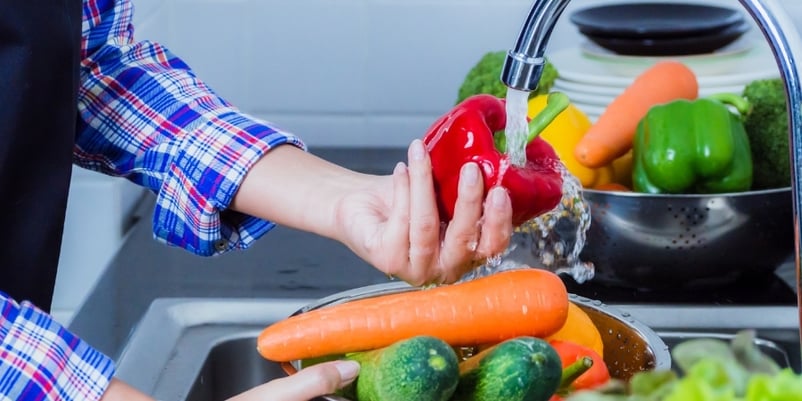
Why Baking Soda?
Baking soda is best for removing pesticides and residues both on the surface and beneath the skin of most produce. A ratio of 1 teaspoon of baking soda per 2 cups of water is recommended.
Here are Some Quick and Easy Ways to Wash Fruits and Vegetables using Baking Soda:
Washing Vegetables
For leafy greens
- Fill a medium to large-sized bowl with the greens, cover with cold water
- Add a teaspoon of baking soda, mix well
- Allow your greens to soak 1-2 minutes, gently stirring them every few seconds
- Drain vegetables in a strainer, thoroughly rinse any residue off, then towel dry the leaves
For vegetables with firm peels
- Fill a medium to large-sized bowl with cold water
- Add a teaspoon of baking soda and then add vegetables
- Soak the vegetables in the solution, between 1-2 minutes
- Grab a scrubbing brush for veggies and gently scrub the surface
- Finally, rinse the vegetables off with fresh water and store or prepare to your liking
Washing Fruits
Smooth-skinned fruits, for example, apples, grapes, nectarines, and plums, can be washed in a baking soda bath through the same process as vegetables.
For berries, avoid soaking them; instead, rinse them under cold water in a strainer. To clean with baking soda, sprinkle a small amount directly on the fruit and gently rub the baking soda in over running water.
Although the thought of leaving your fresh haul of berries from the grocery store unwashed can be troublesome, immediately rinsing your berries increases the amount of moisture inside of them, which produces mold and spoils fruit quicker. So, if you're washing your berries, it's important to do so just before you intend to eat them.
Does water alone effectively clean produce?
When it comes to buying fresh fruits and vegetables, we all understand the importance of healthy and safe eating.
Washing with water reduces bacteria and residues left by pesticides on the surface of fruits and vegetables. Research shows that when used to rinse or soak produce water can remove 98 percent of bacteria from surfaces, more so than cleaning products bought off the shelf.
Water alone is effective at removing some surface residues, but going the extra mile by giving your produce a vinegar or baking soda wash can help to remove any lingering bacteria and also give you peace of mind that you're consuming safe and clean produce.
COVID-19: Food Safety And What You Should Be Doing
The goal of properly washing is to prevent and reduce the ingestion of harmful bacteria that can cause illness.
Here are some helpful tips from the CDC about shopping, selecting, and bringing home fresh produce:
At the Grocery stores or Markets:
- Select produce that's not damaged or bruised
- Keep pre-cut fruits and vegetables cold by selecting produce that is already refrigerated or kept cooled on ice cubes.
- Separate both fruits and vegetables from raw meat, poultry, and seafood in shopping carts and grocery bags.
At home:
- Before and after preparing fresh produce, make sure to wash your hands, kitchen utensils, food preparation surfaces, and surrounding areas;
- Before cutting, eating, or cooking, wash or scrub fruits and vegetables under running water;
- Do not use bleach to cleanse fruits or vegetables. Deter from using any type of disinfecting products on food;
- Keep fruits and vegetables separate from any type of raw foods when storing; and
- Refrigerate fruits and vegetables within a 2-hour timeframe after you cut, peel, or cook them.
Whether we are caught in the middle of a global pandemic or not, make practicing these simple and easy food safety measures a habit.
What Are The Key Takeaways?
An important health habit to have in your back pocket is food hygiene. With the surrounding concerns during the COVID-19 pandemic, shopping and selecting products in grocery stores and markets is just as important as properly washing your fresh produce.
Most produce can be sufficiently and thoroughly washed using cold water, but if you're looking for a cleaning solution that is a little more effective, a vinegar or baking soda solution can do just the trick.
Don't make cleaning your fruits and vegetables an after-thought or a COVID-19 only task; instead, incorporate it into your weekly or monthly shopping habits. Being and staying healthy comes with implementing efficient and safe precautionary measures.
Incorporating these cleansing tips will help keep your fruits and vegetables clean lessening toxic chemicals:
-
Purchase Organic Apple Cider Vinegar for cleansing quality;
-
Use clean forms of Baking Soda that are sustainable such as Thrive Market's brand;
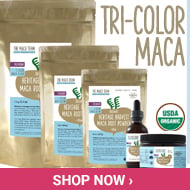
Allow for soaking for at least 5-15 minutes;
-
Use a flexible vegetable brush for better cleansing;
-
After grocery shopping wash fruits and vegetables immediately;
-
Use sustainable storage containers or green bags for longer storage time; and
-
Don't overdo do adding baking soda and apple cider vinegar, avoid waste.
There are really no excuses not to try these nutritional tips. If you are a man or woman looking for specific health benefits or just want to know about the general healing properties of the products that we recommend on our website. Please remember to comment or post any health questions, or contact us directly!
References
The Regents of the University of California. (2020).
NPIC. (2020). How can I wash pesticides from fruit and veggies?
CDC. (2020). Fruit and Vegetable Safety.
Healthline. (2020). How to Wash Fruits and Vegetables: A Complete Guide.
Best Food Facts. (2020). Should I Wash Fresh Fruit in Vinegar?










